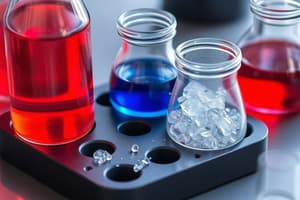Podcast
Questions and Answers
What is the group reagent for the cations of Group II?
What is the group reagent for the cations of Group II?
The group reagent for cations of Group II is hydrogen sulphide in acid medium, specifically 0.3 M HCl.
How does an increase in H+ concentration affect the concentration of S2- ions?
How does an increase in H+ concentration affect the concentration of S2- ions?
An increase in H+ concentration shifts the equilibrium to the left, decreasing the concentration of S2- ions.
What is required to precipitate cations of Group II?
What is required to precipitate cations of Group II?
A relatively small amount of sulphide ion is required to precipitate cations of Group II, controlled by the pH level.
What happens if the acidity is decreased below 0.3 M HCl?
What happens if the acidity is decreased below 0.3 M HCl?
Why is controlling the [H+] important in the precipitation process?
Why is controlling the [H+] important in the precipitation process?
What is the significance of a 0.3 M HCl concentration in relation to S2-?
What is the significance of a 0.3 M HCl concentration in relation to S2-?
How does increasing the acidity above 0.3 M HCl affect Group II cations?
How does increasing the acidity above 0.3 M HCl affect Group II cations?
What is the role of sodium sulphide (Na2S) and sodium hydroxide (NaOH) in the categorization of Group II cations?
What is the role of sodium sulphide (Na2S) and sodium hydroxide (NaOH) in the categorization of Group II cations?
What color precipitate forms when arsenious ion (As3+) reacts with hydrogen sulfide (H2S)?
What color precipitate forms when arsenious ion (As3+) reacts with hydrogen sulfide (H2S)?
How do arsenious and arsenic sulfides react to hydrochloric acid (HCl)?
How do arsenious and arsenic sulfides react to hydrochloric acid (HCl)?
What color precipitate results from the reaction of antimonous ion (Sb3+) with hydrogen sulfide (H2S)?
What color precipitate results from the reaction of antimonous ion (Sb3+) with hydrogen sulfide (H2S)?
What solution can be used to dissolve arsenious and arsenic sulfides after their precipitation?
What solution can be used to dissolve arsenious and arsenic sulfides after their precipitation?
What is the confirmatory test for the presence of Sb3+ ions after their reaction with 12M HCl?
What is the confirmatory test for the presence of Sb3+ ions after their reaction with 12M HCl?
What confirmatory test can be performed after dissolving Sb3+ and Sb5+ with excess sodium thiosulfate?
What confirmatory test can be performed after dissolving Sb3+ and Sb5+ with excess sodium thiosulfate?
What is the color of the precipitate formed when arsenic ion (As5+) reacts with hydrogen sulfide (H2S)?
What is the color of the precipitate formed when arsenic ion (As5+) reacts with hydrogen sulfide (H2S)?
In what chemical state do arsenic and antimony ions exist in solution before precipitation?
In what chemical state do arsenic and antimony ions exist in solution before precipitation?
What happens to stannous sulphide (SnS) in the presence of NaOH or Na2S?
What happens to stannous sulphide (SnS) in the presence of NaOH or Na2S?
What is the role of hydrogen peroxide in the oxidation of stannous ions (Sn2+)?
What is the role of hydrogen peroxide in the oxidation of stannous ions (Sn2+)?
What is the confirmatory test for mercuric ion (Hg2+)?
What is the confirmatory test for mercuric ion (Hg2+)?
How can bismuth (III) ion (Bi3+) be confirmed using excess water?
How can bismuth (III) ion (Bi3+) be confirmed using excess water?
What color is produced when copper (II) ion (Cu2+) reacts with ammonium hydroxide?
What color is produced when copper (II) ion (Cu2+) reacts with ammonium hydroxide?
What is the color of cadmium sulfide (CdS) precipitate when Cd2+ reacts with H2S?
What is the color of cadmium sulfide (CdS) precipitate when Cd2+ reacts with H2S?
Which cations belong to Group II A?
Which cations belong to Group II A?
What happens to arsenious ion (As3+) and arsenic ion (As5+) under group IIB precipitation conditions?
What happens to arsenious ion (As3+) and arsenic ion (As5+) under group IIB precipitation conditions?
What occurs when excess potassium iodide (KI) is added to copper (II) ion (Cu2+)?
What occurs when excess potassium iodide (KI) is added to copper (II) ion (Cu2+)?
Describe the precipitation reaction of mercuric ion (Hg2+) with H2S.
Describe the precipitation reaction of mercuric ion (Hg2+) with H2S.
Flashcards are hidden until you start studying
Study Notes
Group II Cations Overview
- Group II cations are separated into two subgroups: II-a and II-b.
- The group reagent for Group II cations is hydrogen sulfide (H2S) in an acidic medium (0.3 M HCl).
- The basis for the subdivision into II-a and II-b subgroups is the solubility of their sulfides in excess sodium sulfide (Na2S) or sodium hydroxide (NaOH) to form thioanions and oxyanions.
Group II A Cations
- Group II-a cations include: mercuric (Hg2+), bismuth (Bi3+), copper (Cu2+), cadmium (Cd2+), and lead (Pb2+).
- These cations form insoluble sulfides in an acidic medium (0.3 M HCl).
- The precipitation of Group II-a sulfides is controlled by the sulfide ion concentration ([S2-]), which is influenced by the hydrogen ion concentration ([H+]).
- The solubility product of Group II-a sulfides is lower than that of Group II-b sulfides, requiring smaller amounts of sulfide ions for precipitation.
Mercuric (Hg2+)
- Mercuric ions precipitate as black mercury sulfide (HgS).
- Confirmatory tests for mercuric ions include:
- The formation of white mercuric amino chloride (Hg(NH2)Cl) with ammonium hydroxide.
- The reduction of mercuric ions to mercurous ions (Hg2+) with stannous chloride (SnCl2), forming white mercurous chloride (Hg2Cl), which can be further reduced to black mercury (Hgo).
- The formation of scarlet red mercuric iodide (HgI2) with potassium iodide (KI), which can further react with excess KI to form a soluble complex ([HgI4]2-).
Bismuth (Bi3+)
- Bismuth ions precipitate as dark brown bismuth sulfide (Bi2S3).
- Confirmatory tests for bismuth ions include:
- The formation of white bismuth oxychloride (BiOCl) upon the addition of excess water, forming a turbidity.
- The reduction of bismuth ions to black metallic bismuth (Bi) with freshly prepared sodium stannite ([HSnO2]-).
Copper (Cu2+)
- Copper ions precipitate as black copper sulfide (CuS).
- Confirmatory tests for copper ions include:
- The formation of a deep blue solution containing tetraamminecopper(II) ([Cu(NH3)4]2+) upon the addition of ammonium hydroxide.
- The formation of white cuprous iodide (Cu2I2) with potassium iodide (KI) and the simultaneous release of brown iodine.
- The formation of a chocolate brown precipitate of copper(II) hexacyanoferrate(II) (Cu2[Fe(CN)6]) with potassium ferrocyanide ([Fe(CN)6]4-) in an acidic medium.
Cadmium (Cd2+)
- Cadmium ions precipitate as yellow cadmium sulfide (CdS).
- Cadmium sulfide is insoluble in excess sodium sulfide (Na2S) and sodium hydroxide (NaOH).
Group II B Cations
- Group II-b cations include: arsenious (As3+), arsenic (As5+), antimonous (Sb3+), antimonic (Sb5+), and stannic (Sn4+).
- These cations form sulfides that are soluble in excess sodium sulfide (Na2S) or sodium hydroxide (NaOH).
- To separate Group II-b sulfides from Group II-a sulfides, the mixture is boiled with hydrogen peroxide (H2O2), which oxidizes stannous (Sn2+) to stannic (Sn4+).
Arsenious (As3+) and Arsenic (As5+)
- Both arsenious and arsenic ions precipitate as yellow sulfides: arsenious sulfide (As2S3) and arsenic sulfide (As2S5), respectively.
- These sulfides are soluble in excess sodium sulfide (Na2S) or sodium hydroxide (NaOH).
- Arsenious sulfide and arsenic sulfide are insoluble in 12 M hydrochloric acid (HCl) but can be partially dissolved by boiling.
- Confirmatory tests for arsenic ions involve dissolving the sulfides in concentrated nitric acid (HNO3) to form arsenic acid (H3AsO4) and then performing the ammonium molybdate test.
Antimonous (Sb3+) and Antimonic (Sb5+)
- Both antimonous and antimonic ions precipitate as orange sulfides: antimonous sulfide (Sb2S3) and antimonic sulfide (Sb2S5), respectively.
- These sulfides are soluble in excess sodium sulfide (Na2S) or sodium hydroxide (NaOH).
- Antimonous sulfide and antimonic sulfide can be dissolved in 12 M hydrochloric acid (HCl).
- Confirmatory tests for antimony ions involve dissolving the sulfides in 12 M HCl and then performing the following tests:
- Formation of an oxysalt, which is a white turbidity when water is added to the solution.
- The addition of sodium thiosulphate (Na2S2O3).
- To test specifically for Sb3+ when Sn4+ is present, oxalic acid is added, which forms complexes with both ions.
Stannic (Sn4+)
- Stannic ions precipitate as brown stannic sulfide (SnS2).
- After boiling with hydrogen peroxide (H2O2) to oxidize stannous ions (Sn2+) to stannic ions (Sn4+), stannic sulfide is soluble in excess sodium sulfide (Na2S) or sodium hydroxide (NaOH).
- The excess hydrogen peroxide must be decomposed by boiling to prevent oxidation of the hydrogen sulfide reagent to colloidal sulfur.
Studying That Suits You
Use AI to generate personalized quizzes and flashcards to suit your learning preferences.




